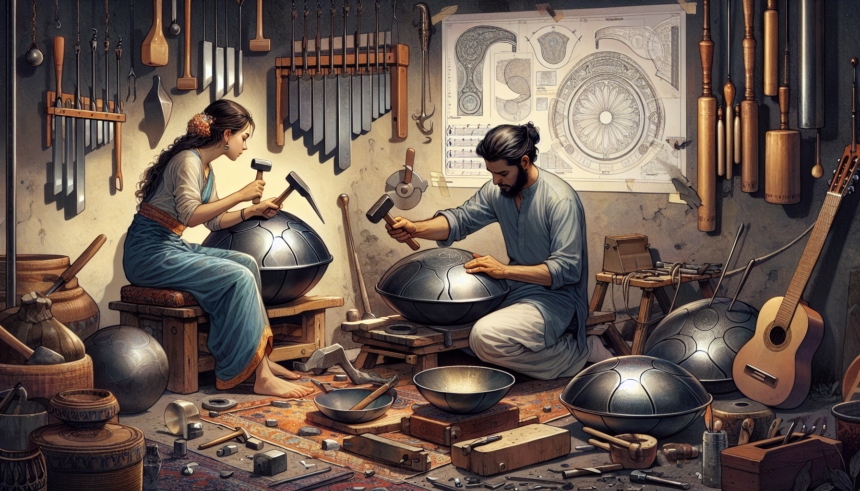Introduction
The handpan is a relatively new musical instrument that has captivated the world with its enchanting sounds and unique shape. While it seems like a simple piece of metal with several dents, the handpan’s creation involves a blend of artistry, acoustics, and engineering. This article delves into the intriguing story behind the handpan’s invention, exploring its origins, development, and the principles that make it a remarkable piece of musical ingenuity.
The Origins
To truly understand the handpan, we must go back to its root inspirations. The Hang, developed in Bern, Switzerland in the year 2000 by Felix Rohner and Sabina Schärer of PANArt, is considered the direct precursor to the handpan. The Hang itself was inspired by several traditional instruments, primarily the Trinidad steelpan and the Indian ghatam. Combining the percussive melodic capabilities of these instruments, Rohner and Schärer embarked on a journey to create something entirely new.
The word “Hang” comes from the Bernese German word for “hand,” which signifies the instrument’s mode of play. Unlike other percussion instruments that require sticks or mallets, the Hang—and consequently, the handpan—is played using the hands and fingers, allowing for a more intimate interaction between the musician and the instrument.
The Development Process
The invention of the Hang was not a straightforward process. Rohner and Schärer spent years experimenting with different metals, shapes, and tuning techniques. Their workshop became a hub of relentless innovation, trials, and errors. They used high-quality Pang composite metal for the shell and meticulously hammering the metal into a precise shape to produce the desired resonant frequencies.
Each Hang or handpan consists of a central note, referred to as the Ding, surrounded by additional tone fields. The placement and tuning of these tone fields are crucial for the instrument’s acoustic properties. The harmonic richness, sustain, and clarity of the notes are achieved through a delicate balance of material science and craftsmanship.
Refining the Design
After the prototype phase, Rohner and Schärer recognized the potential of their creation. However, they knew there was room for improvement. They focused on refining the instrument’s ergonomics, tuning stability, and durability. Each new version of the Hang brought about subtle changes and enhancements.
One of the most significant challenges was to ensure that the instrument could be consistently replicated while maintaining its acoustic perfection. This required precise control over the manufacturing process, as even tiny deviations could affect the sound quality. The final result was an instrument that not only sounded ethereal but also felt organic and intuitive to play.
The Birth of the Handpan Movement
As the Hang gained popularity, other craftsmen and musicians around the world became inspired to create their own variations, giving birth to what is now known as the handpan movement. The handpan family encompasses a variety of instruments, all of which share the core principles of the Hang but often include different materials, shapes, and tunings.
Artisans and manufacturers from different countries started experimenting with their own designs, leading to a diverse range of handpans with unique characteristics. The competition and collaboration among handpan makers have resulted in constant innovation and improvement within the community, driving the instrument’s evolution further.
The Handpan Community
One of the most fascinating aspects of the handpan’s journey is the community that has grown around it. Handpan players, makers, and enthusiasts form a close-knit network that fosters a spirit of collaboration, sharing knowledge, and mutual appreciation for the instrument’s beauty.
Festivals, workshops, and gatherings dedicated to handpan music are held worldwide, providing a platform for artists to perform, teach, and learn. Social media and online forums also play a crucial role in connecting the global handpan community, facilitating discussions on playing techniques, maintenance tips, and new developments in the field.
The Handpan’s Global Impact
In the two decades since its invention, the handpan has made a significant impact on the world of music. Its soothing, meditative sounds have found a place in various genres, from world and new age music to contemporary and even electronic compositions. Moreover, the handpan’s accessibility makes it suitable for both professional musicians and enthusiasts alike.
Many artists have embraced the handpan as a solo instrument, while others integrate it into ensembles or fusion projects. The instrument’s versatility allows for endless creative possibilities, making it a fertile ground for musical exploration and innovation.
Conclusion
The journey of the handpan from a conceptual spark in the minds of Felix Rohner and Sabina Schärer to a globally cherished musical instrument is a testament to the power of innovation and artistic vision. It represents the harmonious blend of tradition and modernity, science and art, music and craftsmanship.
The handpan’s allure lies not just in its celestial sounds but also in the story of its creation—a story of passion, perseverance, and community. As it continues to evolve and inspire, the handpan reminds us of the endless possibilities that arise when creativity and dedication come together to craft something truly exceptional.
Frequently Asked Questions (FAQs)
1. What is a handpan?
A handpan is a type of percussion instrument that is played with the hands. It consists of a central note called a Ding surrounded by several tone fields, each producing a different pitch. The handpan is known for its soothing, melodic sounds and is a derivative of the original Hang instrument developed by PANArt.
2. How is a handpan different from a Hang?
The Hang is the original instrument created by Felix Rohner and Sabina Schärer of PANArt, while the term “handpan” encompasses various instruments inspired by the Hang. Although both share similar design principles, handpans are created by different makers and may include variations in material, shape, and tuning.
3. How is a handpan made?
Creating a handpan involves carefully shaping and tuning metal into a precise form. High-quality steel or other metal alloys are often used. The process includes hammering, heating, and fine-tuning the instrument to produce specific resonant frequencies. This requires a combination of craftsmanship and understanding of acoustics.
4. Can beginners play the handpan?
Yes, the handpan is accessible to beginners due to its intuitive nature. Unlike many other instruments, the handpan does not require prior musical experience and can be enjoyable to play from the start. There are numerous resources, including tutorials and workshops, available to help beginners learn and improve their skills.
5. Why are handpans often considered expensive?
The cost of a handpan reflects the detailed craftsmanship, high-quality materials, and extensive tuning process involved in its creation. Each handpan is carefully handcrafted to ensure the best possible sound quality. Additionally, the demand for handpans often exceeds supply, contributing to their higher price point.





